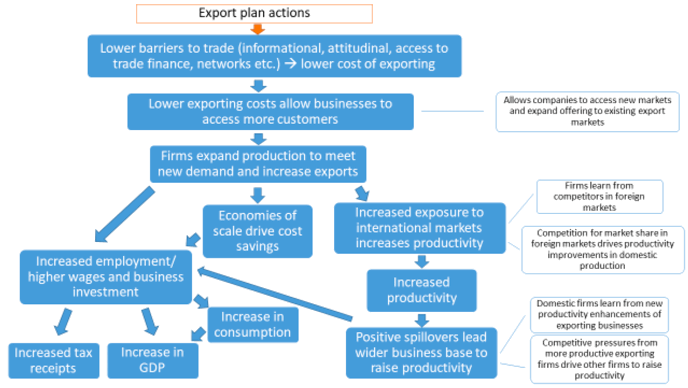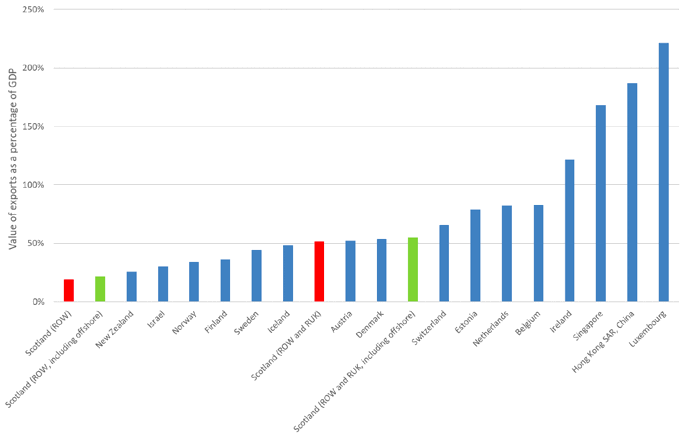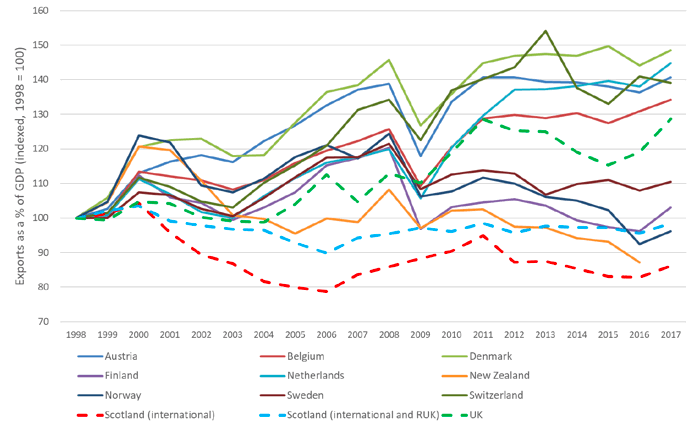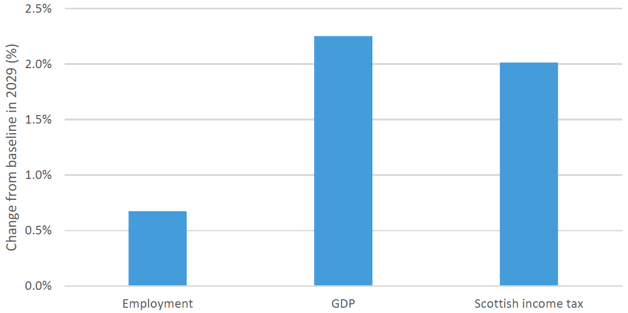A Trading Nation: analytical methodology note
An analytical methodology note produced to accompany the publication of A Trading Nation - a plan for growing Scotland's exports
2. Economic rationale for the Export Growth Plan
6. Evidence shows that companies which trade internationally tend to be more innovative, more productive and more competitive.
7. Economic theory and empirical evidence demonstrate the significant gains that can be achieved both at the firm and economy level through exporting. Not only can higher exports boost economic growth by contributing directly to GDP, but in addition trade improves productivity over time through the diffusion of new technology, increased competition, investment and exploitation of economies of scale. These economy-wide benefits deliver improvements to individuals through creating more jobs and raising wages.
8. Improvements in productivity support sustainable economic growth. Analysis of firm-level data in the UK suggests that businesses which report goods exports were around 20% more productive than businesses which do not trade after controlling for their size, industry and ownership status[2]. Research has also found that exporters typically pay higher wages than non-exporters, reflecting their ability to exploit economies of scale, and realise productive gains.[3]
9. The economic literature suggests a strong two-way link between exporting and innovation, with innovation helping or encouraging a firm to export in the first place and exporting itself also driving investment in innovation and R&D. Evidence from the Small Business Survey Scotland 2017 shows that, in 2017, SME exporters were more likely than SME non-exporters to have innovated in the previous three years.[4] 33 per cent of SME non-exporters had innovated compared to 66 per cent of SME exporters.
10. The benefits relating to exporting are particularly relevant to SMEs, who employ the majority of the labour force in Scotland.Smaller firms typically have less access to learning opportunities than large firms do. Engaging in international trade however gives SMEs greater access and knowledge of different markets and production technologies.[5]
11. Figure 1 shows the transmission channels by which a reduction in barriers to trade (achieved by reducing market failures and other barriers) can impact on the wider economy, including on jobs and GDP. Empirical evidence suggests that greater openness to trade leads to higher incomes, with the OECD estimating that a 10% increase in openness to trade is associated with a 4% increase in income per head.[6]
Figure 1: Wider economic impact of Export Growth Plan actions; economic transmission channels

12. While international trade has undoubtedly been a major contributor to the rapid growth in living standards globally it can also have significant distributional impacts within an economy. In particular, impacts on groups within society such as businesses, consumers and workers may vary, as may the impacts on different regions.
13. For example, economic theory suggests that for developed countries that specialise in sectors that use high-skilled labour, increased trade may lead to greater demand for high skilled workers relative to low-skilled labour. This may lead to higher wages for high-skilled workers relative to low-skilled workers.
14. The evidence for this happening in practice is far from conclusive. While some studies do find that trade can affect inequality within countries, most studies find that the impact of trade on inequality is fairly modest. Instead, technological change is found to be a much more significant factor in changes in inequality[7]. Economists tend to find that the solution is not restriction of trade, which can harm prosperity and growth, but rather ensuring measures are in place within countries to complement trade and protect against rising inequality, such as effective tax systems, education programmes and retraining programmes.
Market failures
15. There is good evidence that market failures and other barriers are present that prevent Scottish companies from fully exploiting potential export opportunities.
16. From an export perspective, market failure refers to circumstances whereby barriers to exporting mean that the actions of each exporter do not lead to an optimal outcome for the whole of society. In particular, market failures in the exporting market tend to reduce both the number of companies that export and also the value that each business exports.
17. Market failures relevant to exporting include:
- attitudinal barriers (misperceptions of the costs and benefits of exporting that lead to businesses being less globally minded)
- informational barriers (lack of access to good information on opportunities)
- internal capacity barriers (lack of in-house specialist knowledge)
- network barriers (lack of access to in-market networks)
- cost barriers (lack of access to export finance or over-estimation of exporting costs)
- positive ‘spill overs’ from exporting (lower positive spill overs than socially optimal)
18. The economic literature highlights that businesses who have the potential to export often don’t export because they lack information on foreign markets and don’t consider it to be cost-effective to pay for their own in-market research (informational and internal capacity barriers). For instance, businesses often lack information on where the potential demand for their goods may be, or don’t have the right networks to capitalise on foreign market opportunities (network barriers). Survey evidence suggests that around half of UK non-exporters with a product suitable for export find access to customers and networks a major barrier.[8]
19. As well as the direct cost to exporting businesses imposed by these market failures, these barriers also have impacts on the wider economy. The economic literature provides evidence that the benefits built up by exporters can ‘spill over’ to other firms, either through social networks, movement of staff, or demonstration effects[9]. Barriers reduce the extent to which this knowledge ‘spill over’ can occur. In addition, these wider benefits are often not reflected in the incentives for individual businesses to increase their export activity, leading to lower levels of exporting than may otherwise be “socially optimal”.
20. The presence of these market failures demonstrates the clear role for government in helping Scottish businesses to overcome these barriers and increase their exports.
Scotland’s export performance
21. While Scotland’s exports have increased in value terms over the last 20 years they have remained broadly static as a proportion of GDP, whilst those of many similar sized nations have increased. In fact, Scotland’s international exports have fallen as a proportion of GDP over the last two decades, from 23% of GDP in 1998 to 20% of GDP in 2017. Some of this decline can be attributed to specific events, particularly the decline in Scotland’s electronics manufacturing (the so called ‘Silicon Glen’). However, the general static trend shows that Scotland has not been internationalising at the same pace as its competitors.
22. Including ‘exports’ from Scotland to the rest of the UK shows a similar picture, with rest of UK plus international exports as a proportion of GDP remaining at around 53% for the last twenty years. Furthermore, recent research has indicated that Scotland lags behind the rest of the UK on a range of indicators relating to export performance, for example in the number of firms engaged in exporting.[10] This highlights that there is a significant and continuous ‘export gap’ that is restricting a greater realisation of benefits from trade compared to the rest of the UK.
23. Figure 2 shows Scotland’s exports as a percentage of GDP as compared to other small, advanced economies. The red columns only include the onshore economy, with the first red column showing this index when calculated for Scotland’s international exports (labelled as Scotland (ROW)), and the second showing this index when calculated including Scotland’s exports to the rest of the UK (labelled as Scotland (ROW and RUK)). The green columns include exports of oil and gas from production in Scottish waters in the calculations.[11]
24. Figure 2 suggests that the share of Scotland’s economy that receives the benefits that international exporting can deliver is low when compared to other small advanced economies, at 19%. These benefits can accrue not only to those firms directly engaging in exporting but also to those in their supply chain. Including Scotland’s exports to the rest of the UK raises the share to 51%, pushing Scotland closer to the middle of the distribution. However, even including these UK ‘exports’ Scotland still lags behind other small advanced economies such as Switzerland, Belgium and Ireland. Although including the offshore economy raises Scotland’s exports, it also increases Scotland’s GDP so the impact on the ratio of exports to GDP is smaller.
Figure 2: Exports as a percentage of GDP; selected small, advanced economies

Source: World Bank and OCEA calculations based on Quarterly National Accounts Scotland and Supply and Use Satellite Accounts for Extra-Regio Economic Activities
25. Figure 2 shows a snapshot of the international exposure of Scotland’s export sector for 2016. Figure 3 examines how the international export penetration of Scotland’s companies has changed over time. Values are indexed at 1998 = 100.
26. It shows that Scotland’s international exports have fallen as a percentage of GDP (red dashed line) over the period, and Scotland’s international and rest of UK exports as a percentage of GDP (blue dashed line) have remained around the same for the last two decades. Meanwhile, UK exports as a percentage of GDP (green dashed line) have grown by almost 30% over the period, as have those in other countries such as Denmark and Norway.
Figure 3: Exports as a percentage of GDP; selected small advanced economies, indexed 1998 = 100

Source: World Bank and OCEA calculations based on Quarterly National Accounts Scotland
27. The Export Growth Plan sets a target of increasing Scotland’s exports as a percentage of GDP from 20% to 25%. New modelling from the Office of the Chief Economic Adviser assesses the impact of meeting this target on the Scottish economy. This is described in detail below.
Illustrative economic impact of the Export Growth Plan target
28. The Scottish Government Global Econometric Model (SGGEM) has been used for this analysis. SGGEM is a large scale structural global econometric model, created for the Scottish Government by the National Institute of Economic and Social Research (NIESR) and is based on an adaptation of NIESR’s own National Institute Global Econometric Model (NiGEM). NiGEM is used by a number of organisations, such as the European Central Bank and the Bank of England.
29. The model covers over 60 countries and regions, and includes over 5,000 variables. Each economy is linked through trade and competitiveness, and they are determined simultaneously. The core of the model consists of a production function determining output in the long term, which is based on the labour force, productivity, and the capital stock. There are also integrated models of the labour market (including wages, consumption, personal income and wealth), government, financial, and non-financial sectors, and international trade. The model uses historical data to determine the speed of adjustment back to equilibrium in response to a shock.
30. As is standard practice with the application of such models, the approach is to first model a baseline scenario and then to compare the results from the baseline to what would happen under an alternative scenario, in this case, the alternative scenario being an increase in international exports to 25% of Scottish GDP by 2029. The change between the baseline and alternative scenarios then provides the illustrative economic impact of the Export Growth Plan target.
31. The baseline scenario assumes GDP and international exports will continue to grow to 2029. The modelling made the following assumptions for the baseline scenario:
- GDP grows by on average 1.2% a year between 2019 and 2029. This outlook for the Scottish economy is broadly consistent with the Scottish Fiscal Commission's December 2018 Economic and Fiscal Forecasts, which forecast average of growth 1.1% over their five year forecast period;
- International exports grow broadly in line with GDP, meaning that they remain at around 20% of GDP over the forecast period.
32. The alternative scenario modelled the impact of increasing international exports as a share of GDP by 5 percentage points by 2029. The modelling made the following assumptions for the alternative scenario:
- The size of this shock was calibrated to achieve the required 5 percentage point increase. This was done by increasing the baseline international exports sufficiently to meet the target assuming no change in GDP. This increase was then calibrated over a number of iterations to adjust for the fact that increasing exports also leads to increases in GDP. The final analysis assumes that real exports would be 25% higher than in the baseline scenario in 2029.
- This increase was phased in linearly between 2019 and 2029, with international exports increasing by an additional 2.3% each year over the baseline.
33. The results are shown in Figure 4 and report the change from baseline in 2029 (that is, the difference between the baseline and alternative scenarios). Overall, the economy is 2.3% larger in 2029 than it would otherwise have been in the baseline scenario. This is larger than the percentage increase in employment due to the fact that existing workers also see an increase in earnings. Such an outcome would also boost tax revenue. For example, Scottish income tax receipts are estimated to be 2% higher in 2029 as a result of reaching the target than they otherwise would have been.
Figure 4: Illustrative economic impact of achieving the Export Growth Plan target

Source: OCEA calculations
34. Table 1 shows the impact of achieving the target in level terms. In order to control for the effects of inflation, the economic impacts are expressed in 2017 prices and relative to the size of the economy in 2017.
Table 1: Impact of increasing international exports to 25% of GDP
| Economic impact (£’s in 2017 prices) |
|
|---|---|
| Employment |
+17,500 people in work |
| GDP |
+£3,500 million |
| Scottish income tax |
+£500 million |
Contact
Email: stefan.hoyte@gov.scot
There is a problem
Thanks for your feedback